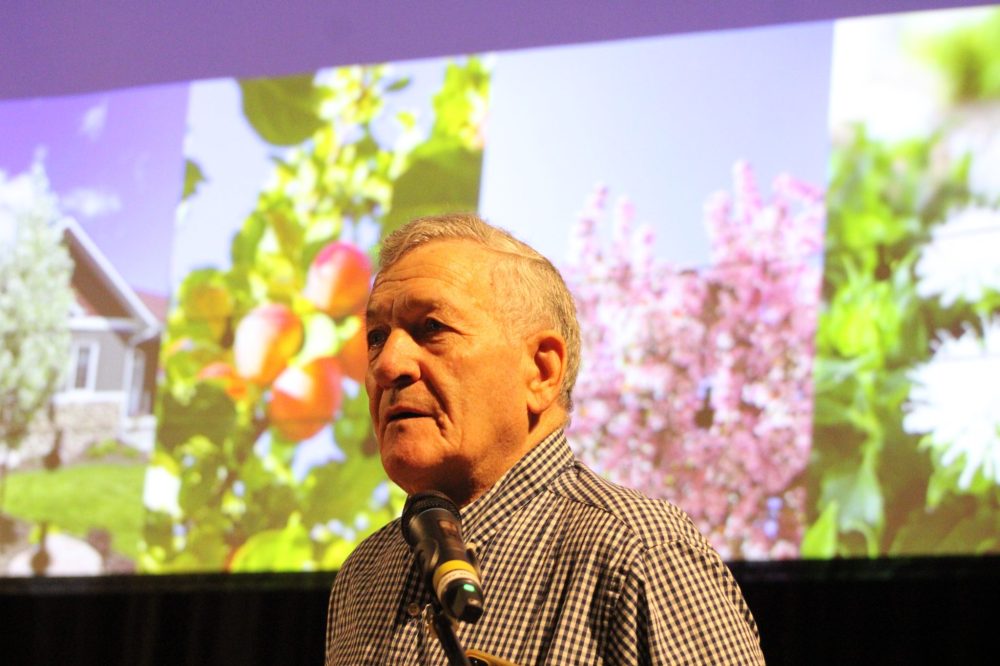Speaker talks trees and trends
Advertisement
Hey there, time traveller!
This article was published 16/01/2024 (483 days ago), so information in it may no longer be current.
Wilbert Ronald has seen popular trees come and go over the years. He’s seen disease decimate street plantings and change priorities for homeowners and communities.
As owner of the Portage-based Jeffries Nurseries, his livelihood depends on being aware of trends.
After all, every year his business sells bare root smaller trees for shelterbelts, containerizes about 40,000 trees, digs about 6,000 field trees in wire baskets and moves around 100 larger trees with large truck mounted tree spades.

He shared his knowledge Monday with a group at the Mennonite Heritage Village as the Steinbach and Area Garden Club hosted his presentation titled “Trees, trees, trees.”
Ronald, who has a PhD in horticulture, plant breeding, covered the bases when it came to trees, highlighting new species, discussing his favourite trees and explaining what it takes to get a new tree from its humble beginnings to your local greenhouse.
He said tree diversity has become more of a trend after the elm population was devastated by Dutch elm disease (DED) and the arrival of the Emerald Ash Borer.
“We’re moving toward trying to plant other trees like Asiatic elms, hackberry, silver maple,” he said. “We have a seedless silver maple that’s very good now.”
Dutch elm disease was discovered in the East Selkirk area of Manitoba in 1974. Since then it’s claimed from three to five percent of the elm population annually despite valiant efforts from cities and individuals to retain their tree canopy.
Ronald said they didn’t grow elms at all for 20 years but have discovered there’s still a market.
“People still want elms because they’re tough as nails,” he said.
And while they’re always developing new trees, Ronald said it takes a long time to change the market.
“It takes us five years to produce them and often 15 years for the arborists and the cities to start specifying those trees,” he said.
The Emerald Ash Borer has entered Manitoba but has not thrived as it has in other areas. Ronald said in Zone 4 to 6, ash trees have been decimated.
The top selling tree remains the Autumn Blaze Maple, though Ronald said it has issues with hardiness and isn’t really meant for Zone 3.
A new tree set to come out is the Freeman Maple, a hybrid of silver and red maples that give vivid fall colour, better branching crowns and improved hardiness.
“We’ve been working on that one for 25 years,” he said.
Other trees growing in popularity include the sugar maple, which Ronald said is grown from northern stock which can thrive in our climate.
“We, along with earlier pioneers have worked on this for many years and have found strains from northwest Minnesota that do well in prairie regions,” he said in his presentation. “I have seen our strain used in the northern Swan River Valley and even growing as far north as Yellowknife. It is now your tree to use.”
Work continues on DED-resistant elms including Asiatic elms. The Freedom elm has performed well in Winnipeg for 40 years and Ronald said he does not know of a single case of Dutch elm disease in that tree.
A black-knot resistant Schubert cherry has been developed over 30 years. “We are increasing this selection and it should bring the purple-leafed cherries back into the landscape.”
Sterile flowering crabapples are also being produced to allow the trees to be used in high-traffic areas.
“We are working on genetics that will give smaller fruit and fruit that is held on the tree for birds to eat in winter,” he said. “Starlite is our best green-leafed selection to date and we continue to work on improved purple foliage forms.”
A push to grow more native trees is one that Ronald understands but says is challenging.
“I’m all for native trees but we’re pretty limited in native trees,” he said. “Without some of the introduced trees we don’t have a lot to choose from.”
That would rule out many trees such as the Amur maple, pears and plums from Asia and apples from Europe.
“We have hackberry but silver maple isn’t native, red maple isn’t native, sugar maple’s not native so whether we use that native term for Canada or Manitoba is quite different,” he said. “Native to Manitoba is a very restricted area.”
As club members filtered out after the session, Ronald had nothing but praise for the Steinbach and Area Garden Club.
“I think you’ve got a great club here,” he said. “You’ve got enthusiasm, you’ve got some younger people, some older people as well and you’re a growing community and you need more trees.”
He also feels he owes a debt of gratitude to this region as many local greenhouses and nurseries source trees from Jeffries.
“I owe a lot to making my living in this area, so I’m glad to come and talk to you,” he said.
